Development of human, social and relationship, and intellectual capital
Employment in times of change
To continue to play a key role within an ever-changing environment while continuing to lead in an international market abundant with opportunities, it is to enhance know-how and know how to meet new challenges in the regulated and free market alike.
People are called upon to effectively share their expertise and know-how and work as a team striving for a single objective: a decisive factor for creating innovation and bringing value to the business. The strong sense of belonging to the Group makes it possible to actively engage all employees in continuous improvement, which is increasingly driven by an entrepreneurial spirit, simplification and implementation capacity.
In this way Snam, in line with the goal of sustainable development, continues to generate “good employment” featuring stable and continuous working relationships involving qualified and specialist activities (57% of employees have a technical diploma and 27% are graduates). In addition, the Company’s objective, through the Snam Institute is to develop know-how, not only within the business, but also on the outside.
As of 31 December 2019, out of a total of 3,025 employees, 93.1% have a permanent employment contract, including 38 part-time employment contracts, and 193 apprenticeships. The average age of Snam Group employees is 44.4 years, while the average length of service is around 18.6 years.
| Download XLS (20 kB) |
(no.) |
2017 |
2018 |
2019 |
|---|---|---|---|
Executives |
93 |
107 |
111 |
Middle Managers |
456 |
480 |
493 |
Office workers |
1,655 |
1,682 |
1,683 |
Manual workers |
715 |
747 |
738 |
Total employee |
2,919 |
3,016 |
3,025 |
| Download XLS (20 kB) |
(no.) |
2017 |
2018 |
2019 |
||
|---|---|---|---|---|---|
|
|||||
Permanent contract |
2,755 |
2,812 |
2,817 |
||
- of which part time contract |
42 |
41 |
38 |
||
Apprenticeship or internship contract |
150 |
185 |
193 |
||
Fixed-term contract |
14 |
19 |
15 |
||
| Download XLS (20 kB) |
(no.) |
2017 |
2018 |
2019 |
|---|---|---|---|
Hired from the market (total) |
148 |
195 |
172 |
- of which university graduates |
100 |
108 |
92 |
- of which school graduates |
48 |
86 |
79 |
- of which other another title |
- |
1 |
1 |
- of which women |
53 |
42 |
38 |
Other new employees (non-consolidated companies, tender acquisitions, etc.) |
36 |
126 |
59 |
Age diversity: employees by age bracket (no.)
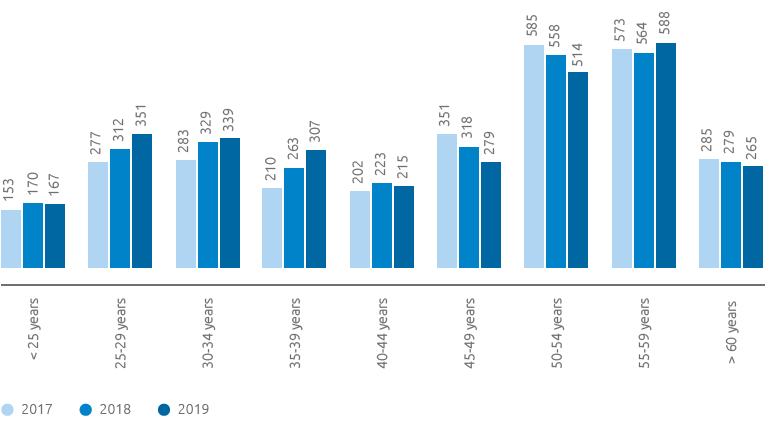
Absenteeism rate (%)
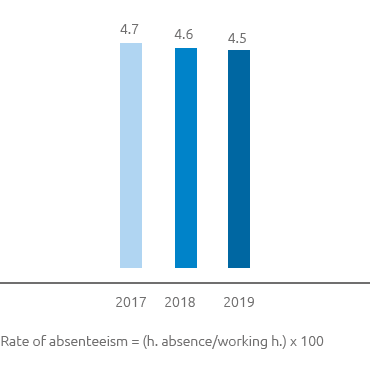
Personnel turnover (%)
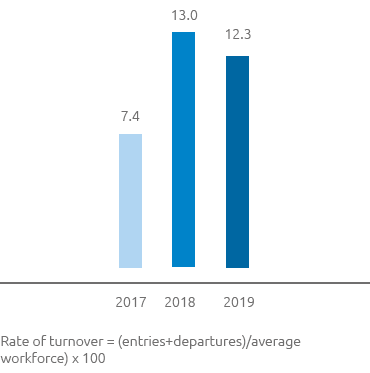
Entrance from the market and departures for female gender (no.)
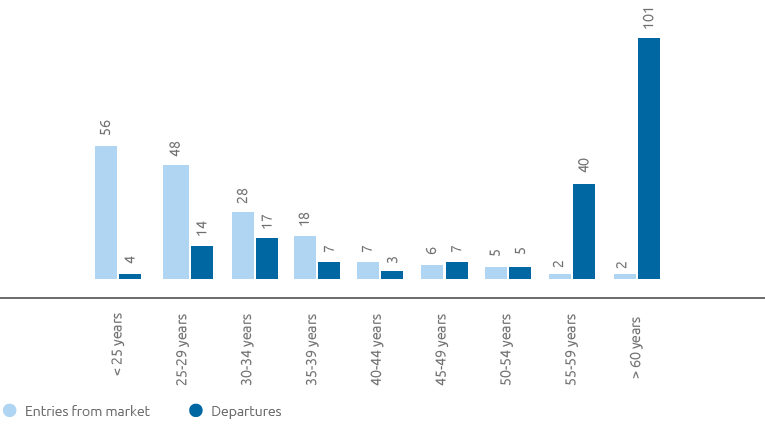
People aged under 40 (1,164) represent 38.5% of the corporate population, an increase of 90 resources compared with 2018, also thanks to the inclusion of young talent in recent years.
The absenteeism rate does not include senior managers and it was calculated taking into consideration all hours not worked (paid and unpaid) excluding holidays, leave that has to be made up and periods of mandatory and voluntary maternity leave. In 2019 the absenteeism rate stood at 4.5%, essentially in line with the figure for the previous year. There were no essential changes between the absenteeism rate for men and women, which stood at 4.4% and 5.1%, respectively.
The turnover rate for 2019, remained consistent with the 2018 figure by virtue of the hiring campaign and incentivising redundancy and early retirement.
Development of roles and skills

In 2019 activities for the development of Snam’s roles and know-how focused on improving the leadership model, consolidating the new skills model, identifying and developing talent throughout the organisation, keeping succession plans solid and structured making it possible to guarantee a sustainable succession line and intensifying the level of engagement. Specifically, the second cycle of the Performance Management system was launched, which saw the expansion of the population to include all administrative staff on site (Corporate and Operations) with 1,587 people evaluated. As planned the Performance Management system will involve the entire corporate population with the launch of the third cycle in 2020.
All work positions, with the exception of senior managers, are subjected to the analytical and overall evaluation of the factors of Complexity, Responsibility, Experience and Autonomy (CREA). In 2019, 225 CREA assessments were approved.
Compensation systems are updated periodically based on a comparison with the reference markets and in consideration of instructions received from external stakeholders. In particular, these systems are meant to ensure recognition of the results achieved, the quality of the professional contribution provided and individual development potential of the person.
| Download XLS (20 kB) |
Executives |
The remuneration system breaks down into two parts: fixed remuneration, with possible annual adjustments for merit or progression of roles/responsibilities, and variable remuneration with incentives aimed at promoting professional contribution in the short-term, by assigning an annual monetary incentive (IMA), as well as in the medium-/long-term, by assigning a long-term share-based incentive (ILT). |
|---|---|
Non-executive population |
Snam adopts a short-term variable incentive plan intended to reward best performance and the young resources with potential for development. |
Training
Training plays a fundamental role in supporting management and the entire company population in pathways to developing managerial capacity, technical skills, and a background of specific expertise.
Precisely in order to preserve technical know-how to develop it and transfer it to the new generations, Skill Centres were set up in 2019: groups of people across the organisational structures who possess consolidated and recognised know-how and expertise in specific areas that are important for the business. The 16 Skill Centres identified involved 110 Group people, identifying 175 experts and 145 trades people, working to create the 16 volumes that make up the Snam technical “trades” encyclopaedia.
These centres are also supported by and internal faculty composed of 80 employees who transfer their technical and business expertise to other colleagues through a by Snam to Snam logic. In 2019 the faculty provided around 1,200 teaching hours, contributing to the training of around 600 people.
In 2019 114,179 training hours were supplied (+5.9% compared with 2018) with 26,518 participants (+89% compared with 2018) involving 99% of the corporate population. The increase is also attributable to the provision of e-learning to the entire corporate population with 5 modules of around 1 hour each, on compliance. The following topics were dealt with: Market Abuse, Privacy, 231 Model, Anti-corruption and Antitrust.
A significant commitment was dedicated to worker training programmes regarding sensitive issues such as health, safety and the environment, by organising a number of meetings to provide updates and information and raise awareness amongst all professional figures.
On matters of business ethics and anti-corruption, in 2019 4,028 hours of training were provided with 3,981 participants.
| Download XLS (20 kB) |
(no. of hours) |
2017 |
2018 |
2019 |
|---|---|---|---|
Executives |
1,908 |
4,392 |
5,669 |
Middle Managers |
8,600 |
19,072 |
16,950 |
Office workers |
39,316 |
49,650 |
58,238 |
Manual workers |
35,522 |
34,657 |
33,322 |
Total |
85,346 |
107,771 |
114,179 |
| Download XLS (20 kB) |
(no.) |
Hours provided |
Participants |
|---|---|---|
Technical training |
47,705 |
8,023 |
Health, safety, environment and quality |
29,755 |
5,580 |
Managerial training |
19,524 |
4,356 |
Corporate welfare and work-life balance
Corporate welfare is a powerful tool that is integrated and integrated with the public welfare system and which attempts to protect people from new social risks. The definition of “corporate welfare” refers to a multiplicity of interventions, both monetary and in the form of services, capable of generating benefits for employees (who see their increasing social protection and their purchasing power) and become a lever fundamental for companies, which benefit from a better working and productive climate. With the goal of promoting a positive working environment, over the years Snam created a welfare system founded on a long tradition of attention to people, capable of growing and changing over a period of time and reaching out towards the emerging needs and requirements of the different categories of employees. The in-depth analysis of the corporate population, different needs and sensitivities, are periodically updated and allow Snam to develop shared, functional and effective services.
From 2018 the welfare offering, available on the Snammy digital platform, is organised over five areas of intervention: Family, Education, Work/Life Balance, Well-being and leisure time, Health These five areas are then broken down into 28 services (corporate and contractual) which enable Snam to respond to the most current needs and requirements of the various bands of employees. Among the innovations in 2019, in the Family area there is BE PARENTS, online training created in conjunction with Life Based Value, which accompanies first-time new parents during and after the birth of their child, developing those skills that are also useful in the workplace. 66 employees took part in the programme (45% of whom were women).
Still in the Family area, digital education courses continued involving children and parents on technological themes and the dediCARE programme is provided, the service that listens to and takes care of needs of a social, work, welfare, economic and health of employees and their families.
In the Well-being and leisure time section, in addition to the arrangements with leading health institutions and prevention programmes, SNAMMYBENE is ongoing, the project dedicated to the well-being of employees that has been rolled out to focus on three aspects: diet, cognitive-emotional and financial.
As far as flexible working is concerned, the Smart Working initiative was extended both in terms of the scope of application and the number of hours, going from a total of 62,930 hours in 2018 to 122,762 in 2019. The programme is supported by flexible working hours for arriving and leaving, and “short Fridays”, where the working day on a Friday can end from 13.00 onwards.
The FLEXIBLE BENEFITS system is also continuing. It allows employees to convert a portion of the performance-related pay (a maximum of 60%) into a welfare credit that can be used to buy various types of services for themselves or their family members. The advantage of the initiative is to increase the purchasing power of employees, given that there is no tax on the amount converted and that the company recognised a further variable bonus from 8% to 16% based on the share converted.
Diversity
For Snam diversity means guaranteeing meritocracy and creating open and inclusive working environments and it represents a value that translates into growth for the company and the country system. In effect, Snam respects everyone’s dignity, and offers equal opportunities throughout all phases and for all aspects of the employment relationship, avoiding all forms of discrimination based on sex, age, health, nationality, political opinion or religious views, a commitment formalised in the publication in October, of a policy dedicated to Diversity & Inclusion.
Snam is also included among the 325 global companies on the 2020 Bloomberg Gender-Equality Index (GEI). The index is based on factors such as promoting female leadership, a commitment to reducing the gender pay gap and the culture of inclusion.
At the end of the year, the female corporate population stood at 441 resources, an increase compared with the previous year (+5.3%). Of the 38 part time contracts in the company, women account for 34 of these.
In order to make the most of diversity, Snam continued in 2019 through collaboration with Valore D, which Snam became a Contributing Member of in 2017. Valore D is the leading association of companies promoting diversity, talent and female leadership for the growth of companies and the country. In 2019 Snam took part in intercompany training and mentoring programmes offered by the association and 3 in-house workshops have been organised on the following subjects: Unconscious Bias, Happiness in the Company and Organisational Leadership. Still during the year, Snam joined InspirinGirls, the international campaign brought to Italy by Valore D which has the goal of creating awareness among young women of their talent freeing them of the gender stereotypes that hold back their ambitions.
As far as people with disabilities are concerned, 120 people with disabilities work in the Group and their career path promotes inclusion and integration in company processes.
| Download XLS (20 kB) |
(no.) |
2017 |
2018 |
2019 |
|---|---|---|---|
Average hours of training provided to men (hours/year) |
31.3 |
36.9 |
38.4 |
Average hours of training provided to women (hours/year) |
15.8 |
28.7 |
33.8 |
Female presence (%)
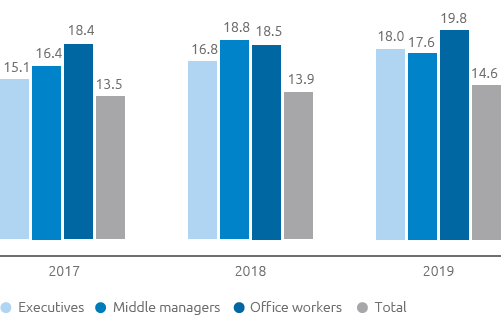
Women hired from the market (no.)
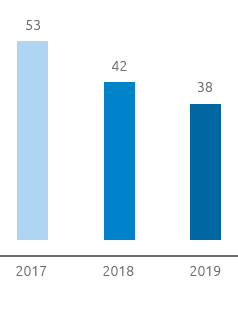
Entrance from the market and departures for female gender
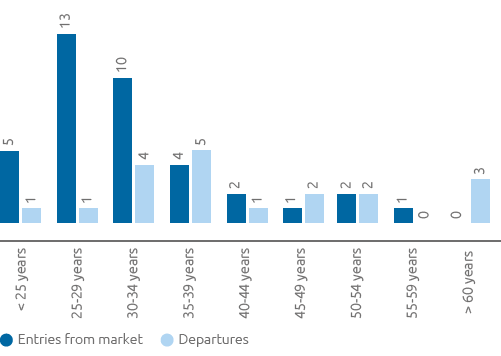
Women/men compensation differential
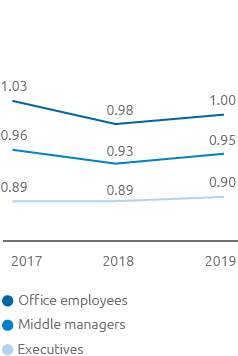
The improvement in the women-men pay gap in 2019 is due to the consolidation of the actions aimed at improving the gender balance in the company.